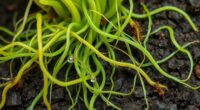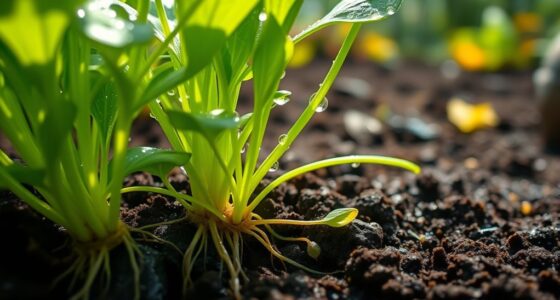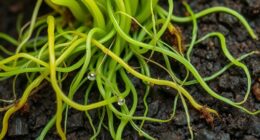When plants lack mobile nutrients like nitrogen, potassium, or magnesium, deficiency symptoms tend to show up first in the older leaves because the plant moves these nutrients to newer growth, leaving the old leaves depleted. If you notice yellowing or browning in older leaves, it’s likely a deficiency of a mobile nutrient. Conversely, deficiencies in less mobile nutrients like calcium appear in new leaves first. Keep exploring to understand how to address these issues effectively.
Key Takeaways
- Mobile nutrients like nitrogen, potassium, and magnesium show deficiency symptoms first in older leaves.
- Less mobile nutrients such as calcium cause deficiency signs in new leaves initially.
- Deficiencies in mobile nutrients lead to yellowing or necrosis in mature foliage.
- Symptoms of immobile nutrients appear in newer tissue because they cannot be redistributed.
- Recognizing symptom location helps identify whether a nutrient is mobile or immobile in plants.

Nutrient mobility refers to how easily essential elements move within plants and soil, directly impacting plant health and growth. When a plant experiences a deficiency, the location of the symptoms often reveals which nutrient is lacking, especially in relation to how mobile that nutrient is within the plant. Understanding this can help you diagnose issues early and address deficiencies more effectively. For instance, Northeast regions with colder soils may experience different nutrient availability, influencing deficiency symptoms. If you notice yellowing or other discoloration appearing first in the older leaves, it’s often a sign that the nutrient involved is highly mobile within the plant. For example, nitrogen deficiency commonly shows up in the oldest leaves first. Nitrogen is crucial for making chlorophyll, so when it’s in short supply, the plant reallocates nitrogen from older tissues to newer growth, causing the older leaves to yellow and eventually die back. Recognizing this pattern allows you to quickly supplement nitrogen, usually through a balanced fertilizer, to restore healthy growth.
Similarly, potassium deficiency tends to show up first in the older leaves, causing them to develop scorched or brown edges and sometimes show signs of necrosis. Potassium plays a critical role in water regulation and enzyme activation, and because it’s mobile, the plant moves it from older tissues to newer ones when deficient. If you see these symptoms, increasing potassium levels through fertilization can often remedy the problem, preventing further decline.
In contrast, deficiencies of less mobile nutrients, like calcium, tend to appear in the newer leaves first. Calcium is essential for cell wall strength and development, but it doesn’t move readily within the plant once deposited. When calcium is deficient, you might notice distorted, curled, or deformed new leaves, along with symptoms like blossom end rot in fruits like tomatoes. Since calcium isn’t easily remobilized from older tissues, addressing this deficiency requires ensuring calcium availability in the soil or through foliar applications directly to the new growth.
Magnesium deficiency, which affects chlorophyll production, usually shows up first in the older leaves with interveinal yellowing—leaves turn pale between the veins but veins stay green. Magnesium is relatively mobile, so the plant reallocates it when deficient, making older leaves the first to show symptoms. Correcting magnesium deficiency involves applying Epsom salts or magnesium-rich fertilizers to supply what’s missing.
Frequently Asked Questions
How Can I Prevent Nutrient Deficiencies in My Plants?
To prevent nutrient deficiencies, you should regularly test your soil and amend it with the right fertilizers. Make sure your plants get consistent watering and avoid over- or under-fertilizing. Use slow-release nutrients or organic options to guarantee steady supply. Keep an eye on your plants for early signs of deficiencies, and address issues promptly. Proper soil preparation and ongoing maintenance are key to healthy, thriving plants.
Do Mobile Nutrients Affect Fruit and Flower Development?
Yes, mobile nutrients crucially impact fruit and flower development. When these nutrients like nitrogen, phosphorus, or potassium are deficient, your plant will first show signs in older leaves, but this also means the plant reallocates nutrients to support new growth. This redistribution can stunt flowering and fruiting, as your plant conserves essential resources. Ensuring a steady supply keeps your plants thriving, blooming, and producing abundant, healthy fruit.
Are Certain Plant Species More Prone to Nutrient Deficiencies?
Yes, certain plant species are more prone to nutrient deficiencies due to their unique nutrient uptake and storage abilities. You’ll notice some plants, like tomatoes and roses, show deficiencies quickly if nutrients are lacking, especially in mobile nutrients like nitrogen and potassium. These plants often exhibit symptoms first in older leaves. To prevent deficiencies, you should regularly monitor soil health, provide balanced fertilization, and adjust care based on the specific needs of each species.
How Do Soil Conditions Influence Nutrient Mobility?
You might think soil is a passive background, but it actively influences nutrient mobility. Poor drainage, for instance, traps nutrients, making them less available, while overly sandy soils drain nutrients quickly, causing deficiencies. Acidic or alkaline pH levels can lock nutrients away, ironically depriving your plants even when nutrients are present. So, soil conditions can either help nutrients travel where needed or hinder their journey, leading to deficiencies.
Can Nutrient Deficiencies Be Corrected After Symptoms Appear?
Yes, you can correct nutrient deficiencies after symptoms appear. Start by identifying which nutrient is lacking through visual signs or testing. Then, apply the appropriate fertilizer or supplement to address the deficiency. Make sure to follow recommended application rates to avoid over-fertilizing. Consistent monitoring and adjusting your approach will help your plant recover and restore healthy growth, even after symptoms have shown.
Conclusion
Understanding nutrient mobility helps you identify deficiencies early. When nutrients move easily, deficiencies show up in new leaves first; when they don’t, old leaves are affected first. Recognize the signs quickly, diagnose accurately, and act promptly. Because healthy plants depend on timely attention, timely action depends on understanding nutrient behavior. Remember, the first sign is often the last to be noticed, so stay vigilant, stay proactive, and nurture your plants with knowledge and care.










